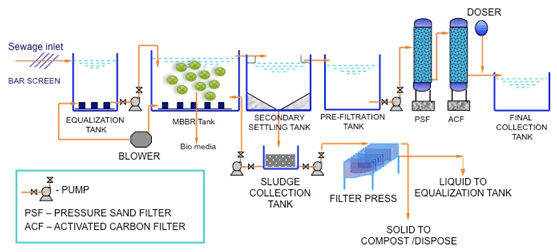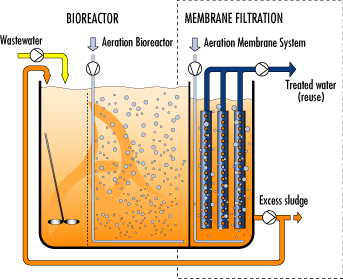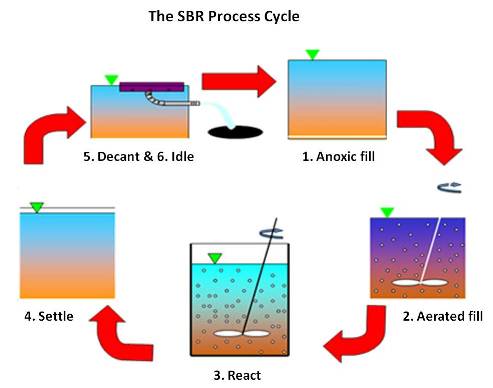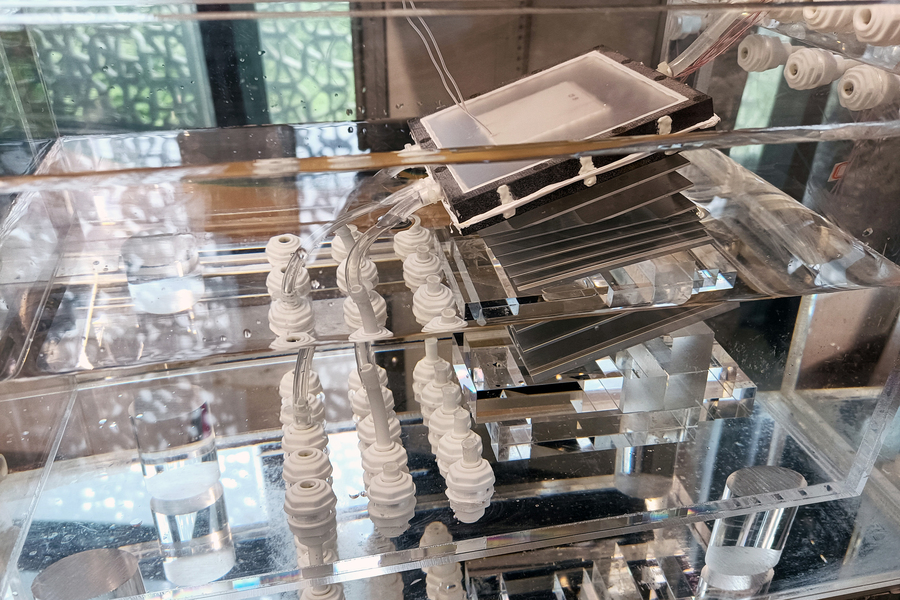

03/01/2025
Water is an essential resource for socio-economic activities and maintaining the life of the environmental ecosystem. In nature, water is an important component for the existence of humans and other organisms. In terms of consumption, water is used for most living and economic activities. Many countries in the world set goals for managing and using water resources safely and effectively in daily life and production. In which, water resource management based on technology is an important part of sustainable economic development. In the scope of this article, we will focus on studying popular environmental technology applications, evaluating the trend of approaching artificial intelligence (AI) and water production methods using renewable energy sources. Thereby, we make some recommendations in water resource management and wastewater treatment.
1. Global context of water resources management
In recent years, environmental degradation has been partly reflected in the water resources on earth. In the report on Vietnam Environment and Climate Change Assessment by the Asian Development Bank (ADB), Asian countries in general and Vietnam in particular are facing rising sea levels, combined with the effects of climate change, increasing salinity intrusion and freshwater degradation. In addition, the development of irrigation and hydropower reservoirs across Vietnam, including some small basins with hundreds of dams, is causing freshwater biodiversity to decline without appropriate monitoring and improvement management programs.
Five years ago, UN figures from 2019 showed that untreated wastewater pollution was a problem in both developed and developing countries. Of these, about 297,000 children die each year from diseases caused by poor water quality and about 80% of wastewater is returned to the environment without being treated or reused. Recent statistics from the Centers for Disease Control and Prevention show that about 446,000 children under the age of 5 die from diarrhea related to inadequate access to safe water and sanitation. This represents 9% of the 5.8 million deaths among children under 5 years old.
The demand for clean and safe water is high, but the supply is severely lacking. The World Bank's annual report on water 2023 shows many difficulties in managing clean water resources. The report notes that 2.2 billion people lack safely managed drinking water, 3.5 billion people lack access to safely managed sanitation, and 2 billion people lack access to basic hand hygiene. According to forecasts, the demand for water continues to increase while water production in countries is very low, accounting for only about 12% of global standards. Also at the 28th United Nations Climate Change Conference in December 2023 held in the United Arab Emirates (UAE), the World Bank on Water forecast that by 2050, an estimated 4 billion people will live in water-stressed areas and 1.6 billion people will face flooding.
2. Application of environmental technology in wastewater treatment
One of the leading causes of water pollution is ineffective wastewater treatment, leading to water being discharged into the environment without going through the decontamination process. In Vietnam, there are a number of large-capacity wastewater treatment plants, including: Yen Xa wastewater treatment plant (Hanoi) with a capacity of 270,000m3/day and night; Nhieu Loc - Thi Nghe wastewater treatment plant (HCMC) with a capacity of 480,000m3/day and night; Binh Hung wastewater treatment plant (HCMC) with a capacity of 328,000m3/day and night… According to Ministry of Natural Resources and Environment, currently the country has 291 industrial parks, but only 265 industrial parks have centralized wastewater treatment systems.
Wastewater treatment is an important process in environmental protection. Developing environmental technology in wastewater treatment plays an important part in the goal of achieving sustainable environmental economic development. Many environmental technologies help effectively remove pollutants, ensuring that wastewater meets standards before being discharged into the environment, bringing high efficiency with sustainable productivity (Syed et al., 2022). Environmental technology in wastewater treatment can be divided into two main groups: physicochemical technology and biological technology (wastewater treatment technology using microorganisms). Modern wastewater treatment technologies have many outstanding advantages over traditional technologies, such as high treatment efficiency, low cost, and environmental friendliness. Some popular wastewater treatment technologies currently used in the world include: Industrial wastewater treatment technology combining traditional Aerotank and aerobic biological method - Moving Bed Biofilm Reactor (MBBR), Anaerobic Anoxic Aerobic organic wastewater treatment technology (AAO), Membrane bioreactors technology (MBR), Liquid waste treatment technology - Sequencing batch reactor (SBR),…

Industrial wastewater treatment technology combines traditional Aerotank and aerobic biological method - Moving Bed Biofilm Reactor (MBBR)

Anaerobic Anoxic Aerobic (AAO) organic wastewater treatment technology

Membrane bioreactors (MBR) technology

Liquid waste treatment technology - Sequencing batch reactor (SBR)
3. Trends in artificial intelligence approaches in urban water resources management
Artificial Intelligence (AI) is one of the breakthrough technologies of the 21st century and is becoming increasingly popular in many fields. For water resources management, AI technology plays a supporting role in many activities such as: monitoring and warning, operational management, forecasting and resource optimization.
AI's Support in Water Resources Management
|
Operation |
Support from AI |
|
Monitoring and alerting |
Check and monitor water quality, water flow, flood levels, etc. to detect problems early and give timely warnings. |
|
Operations Management |
Applying automation technology to water supply and drainage system operating processes helps improve operational efficiency. |
|
Forecast |
Provide forecasts on water demand, impacts of temperature, weather, natural disasters... to serve the planning of more effective water resource use. |
|
Resource Optimization |
Ensure compliance with water supply and drainage procedures, helping to save water and minimize environmental impacts during exploitation and production. |
With the goal of improving the efficiency of water resource management, ensuring water security and environmental protection, the application of AI models in urban water resource management is becoming increasingly popular. AI technology models improve water use efficiency by converting information into cleaner processes, improving data-based decision making. A typical example is the application of machine learning technology in prediction, control and optimization in wastewater treatment activities (Imen et al., 2023).
A recent proposal for intelligent automated water resource planning is called AIDWRP (Xiang et al., 2021). AIDWRP is a subset of AI developed for sustainable data management in urban areas. AIDWRP is used in water supply to increase the overall performance of water infrastructure operations such as asset inspection and repair, energy conservation, and carbon emission reduction, thereby improving the quality and optimizing the cost to citizens of water services provided at local levels.
4. Technology for water production using renewable energy sources
During World Water Week 2023 held in Stockholm, Sweden, Csaba Korosi - President of the United Nations General Assembly emphasized the role of digital technology platforms in water resources management, especially considering the relationship between technology, renewable energy sources (solar energy, wind energy) and consumer energy products (electricity, water).
Many developed countries are deploying solar energy technology systems in clean water production (Li et al., 2021). Some technologies include: analyzing the energy transfer of evaporation and condensation caused by solar thermal conversion to improve the evaporation rate through the solar thermal interface desalination (STID) technology system, desalination technology of seawater or saltwater from 2 systems of solar thermal membrane desalination (STMD) and solar electrochemical desalination (SED), or solar thermal atmospheric water harvesting technology (ST-AWH), which is considered a solution to create clean water in the desert using solar panels. In general, the application of solar energy-related technology in water production has contributed positively to solving the needs of household drinking water, industrial water and personal hygiene in many countries.
Solar water production is the process of using solar energy to convert seawater or saltwater into fresh water. Nowadays, to produce water using solar energy, people often use the desalination method. This is a method that uses solar energy to evaporate seawater, then condenses the steam to obtain fresh water; this method does not produce carbon emissions because it relies on sunlight instead of pressure like other traditional desalination methods. However, because the cost of research and manufacturing, input costs, and operation and maintenance of products using the desalination method are relatively high, it has not been widely deployed in practice, especially in developing countries like Vietnam.
To address the above problem, over the years, the World Bank Group has been the largest investor in water production development projects globally. In 2024, the World Bank will continue its credit subsidy programs for projects aiming at sustainable production based on renewable energy sources by providing concessional loans and technical support for upgrading water infrastructure for governments, improving management methods and ensuring active community participation in protecting water security.
In developed countries like the United States, government funding for research into renewable energy water production has received much encouragement. In 2023, engineers and collaborators at the Massachusetts Institute of Technology (MIT) developed a solar-powered device to turn seawater into drinking water that is significantly cheaper and cheaper to operate than other clean water production devices on the market.

New solar desalination system based on desalination method, heating the system with natural sunlight
(Source: MIT News)
5. Some recommendations
It can be seen that integrating technology into water resources management is an inevitable step to ensure sustainability and efficiency in exploiting, using and protecting water resources. However, to achieve high efficiency, there needs to be strong investment and close coordination between parties in a long-term strategy. Below are some recommendations that Vietnam can consider in the coming time.
Firstly, businesses and relevant agencies and sectors should promote the application of technology in water resources management and wastewater treatment. For example, wastewater treatment technologies such as MBBR, AAO, MBR, SBR or implementing AI models such as AIDWRP in urban water resources management. The great advances in science, modern technologies such as biological filters, advanced chemical treatment not only improve the efficiency of pollutant removal but also minimize the impact on the environment. Investing in smart wastewater treatment systems not only protects water resources but also contributes to building a sustainable future.
Secondly, products that operate on renewable energy are increasingly being widely applied. Vietnam needs to encourage the application of water production technology using renewable energy sources such as solar, wind, geothermal, etc. Utilizing clean energy not only helps reduce greenhouse gas emissions but also ensures a stable supply of clean water for the community. In particular, these systems are often capable of operating automatically and saving energy, contributing to reducing production costs.
Thirdly, although technology is a way to make management activities more convenient and faster, people are still the key to opening the “door” to sustainable development. Therefore, the requirement to raise awareness is extremely essential, especially raising awareness of cybersecurity for officers and employees working in the field of water resources management.
Nguyễn Hoàng Nam
University of Economics Ho Chi Minh City (UEH)
(Source: The article was published on the Environment Magazine by English No. IV/2024)
References
1. Syed, A. R. K., Pablo, P., Zhang, Y., Hêris, G. and Manoj, M. (2022), “Environmental technology and wastewater treatment: Strategies to achieve environmental sustainability”, Chemosphere, 286, Doi: 10.1016/j.chemosphere.2021.131532.
2. Imen, S., Croll, H. C., McLellan, N. L., Bartlett, M., Lehman, G. and Jacangelo, J. G. (2023), “Application of machine learning at wastewater treatment facilities: a review of the science, challenges and barriers by level of implementation”, Environmental Technology Reviews, 12(1), pp. 493-516.
3. Xiang, X., Li, Q., Khan, S. and Khalaf, O. I. (2021), “Urban water resource management for sustainable environment planning using artificial intelligence techniques”, Environmental Impact Assessment Review, 86, Doi: 0.1016/j.eiar.2020.106515.
4. Li, Z., Xu, X., Sheng, X., Lin, P., Tang, J., Pan, L., Kaneti, Y. V., Yang, T. and Yamauchi, Y. (2021), “Solar-Powered Sustainable Water Production: State-of-the-Art Technologies for Sunlight–Energy–Water Nexus”, ACS Nano Journal, 15(8), pp.12535-12566.